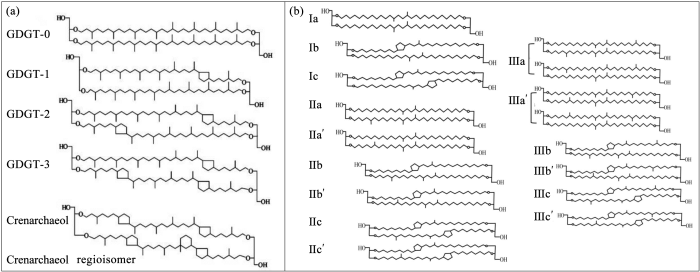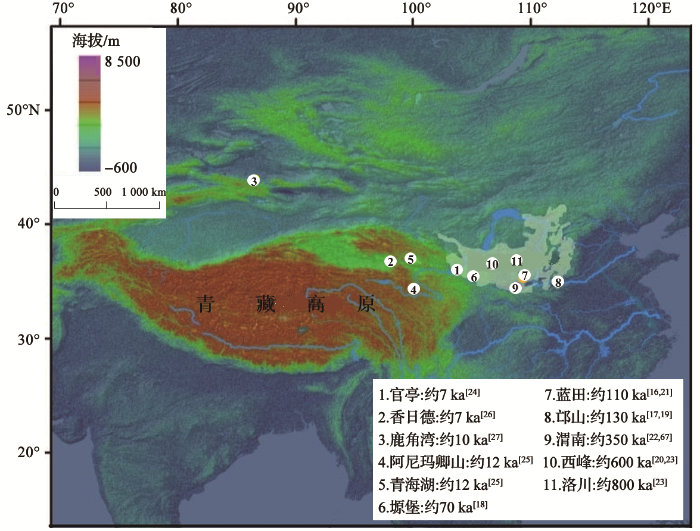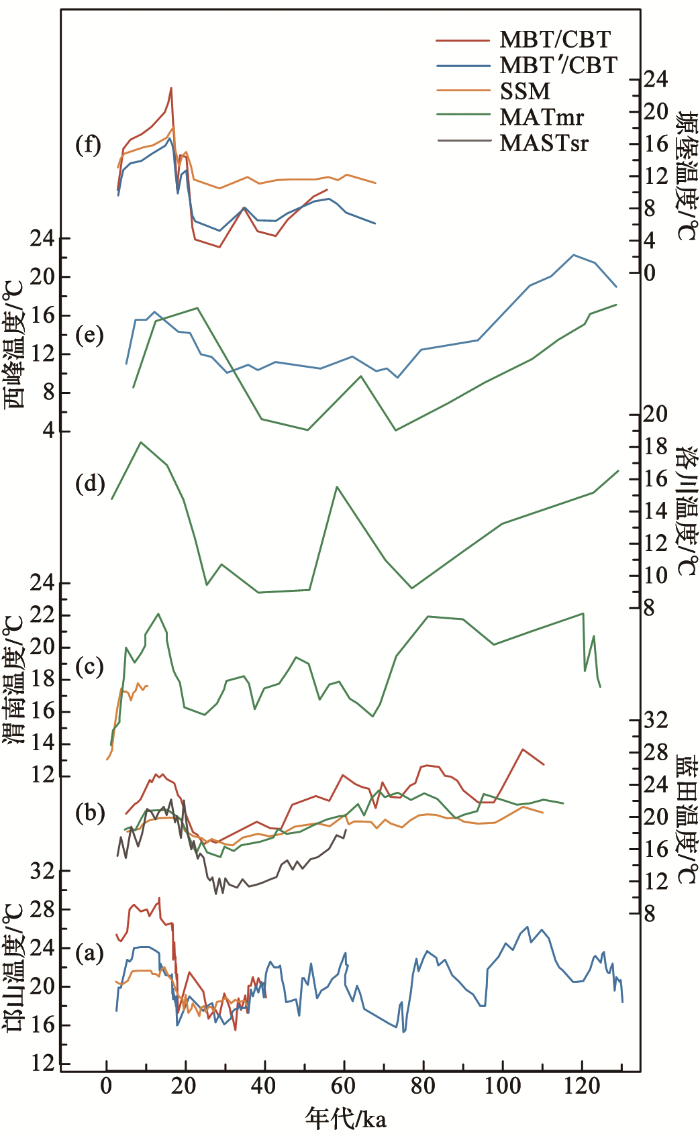1 引 言
甘油二烷基甘油四醚(Glycerol Dialkyl Glycerol Tetraether lipids, GDGTs)是由微生物合成的一大类脂类化合物[13]。微生物通过合成不同分布模式的GDGTs响应外界环境的变化,可敏感指示环境温度[14]、土壤pH[14]和湿度[15]等。在活体微生物细胞中,GDGTs与头基(磷脂、葡萄糖等)可构成完整的极性类脂,微生物死亡后,头基水解,而相对稳定的核心类脂GDGTs却可以在地质体中长期保存,并记录当时的古气候信息[13]。GDGTs广泛分布于黄土[15,16,17,18,19,20,21,22,23,24,25,26,27]、泥炭[28,29]、湖泊[30,31,32,33,34]、海洋[35,36,37,38]和石笋[39,40,41]等不同环境的沉积载体中。因此,作为一类较为稳定的分子化石指标,GDGTs在定量重建第四纪乃至深时古环境(尤其是古温度方面)中发挥了巨大作用[23,36,42,43,44,45]。本文主要介绍GDGTs的结构、生物来源,以及常见的GDGTs古环境代用指标的建立和发展,并重点阐述了其在第四纪黄土古环境重建中的进展及当前研究中存在的问题。
2 GDGTs的结构
图1
图1
GDGTs结构(据参考文献[13]修改)
(a)类异戊二烯GDGTs结构和(b)支链GDGTs结构;由于甲基位的异构,支链GDGTs具有5-和6-甲基支链GDGTs异构体
Fig.1
Molecular structures of GDGTs(modified after reference[13])
Molecular structures of iGDGTs(a)and bGDGTs(b); Due to the heterogeneity of the methyl positions,branched GDGTs have 5- and 6-methyl branched GDGTs isomer
2.1 iGDGTs结构
iGDGTs的碳链为类异戊二烯结构,两侧连接4个醚键。最初研究认为醚键的出现可使微生物适应极端环境[13],但当前更多的研究表明,古菌及其产生的iGDGTs在海洋、湖泊、土壤等普通环境中也广泛存在[16,17,18,19,20,21,22,23,24,25,26,27,28,29,30,31,32,33,34,35,36,37,38]。因此,古菌这类结构的出现可能不仅是为了适应极端环境。不同的iGDGTs分子中含有不同数量的环戊烷,iGDGT-0不含环戊烷,iGDGT-1、iGDGT-2、iGDGT-3分别包含1、2、3个环戊烷(图1a)。而泉古菌醇(Crenarchaeol)及其立体异构体除了含有4个环戊烷结构外,还包含环已烷。在海洋沉积中,环戊烷数量的多少与海水表面温度密切相关[46]。关于iGDGTs甘油的排列方式,学者们在最初进行研究时即存在争议[47,48]。最近,Liu等[49]利用iGDGTs的降解产物甘油二烷基甘油二醚等反推其甘油结构,认为在普通海洋环境中,iGDGTs的甘油构型主要为平行结构,在甲烷厌氧氧化环境中,iGDGTs甘油构型同时存在平行结构和反平行结构。其中Crenarchaeol与其异构体均为平行甘油构型,两者的区别在于环戊烷的排列位置不同。然而Sinninghe Damsté等[50]在此基础上的进一步研究表明泉古菌醇异构体与泉古菌醇的区别在于,与环己烷相连的环戊烷是顺式立体化学结构,这种结构的出现增强了细胞膜的流动性,使其能够适应高温环境。
2.2 bGDGTs结构
常见的传统的bGDGTs有9种,与iGDGTs不同,其碳链为甲基支链。bGDGTs根据甲基数量分为I、II、III 3个系列,不同系列的区别在于甲基的位置和数量不同,每个系列中的a、b、c分别包括0、1、2个环戊烷(图1b)。但后来研究表明,bGDGTs的一些种类中还具有同分异构体。Weijers等[51]指出bGDGT-IIIa化合物实际含有2个峰,具有同分异构体。一些研究者在欧洲黄土中也检测到了GDGTs异构体的存在[52]。但传统的氰基柱(Cyano Nitrile,CN)一般无法分离bGDGTs的同分异构体。De Jonge等[53,54]首次对这一问题进行正式研究,成功分离出更多不同结构的bGDGTs,定义了bGDGTs II系列和III系列化合物的6-甲基同分异构体IIa'、IIb'、IIc'、IIIa'、IIIb'和IIIc',新分离出的bGDGTs的甲基分别位于6、13(13')、15(15')和23号碳上,称为6-甲基bGDGTs,而传统bGDGTs的甲基则位于5、13(13')、15(15')和24号碳上,称为5-甲基bGDGTs。除bGDGTs II系列、III系列具有异构体外,Yang等[55]在神农架地区的土壤中检测到了bGDGTs Ia、Ib的异构体峰,这些化合物与Ia、Ib的比值和土壤pH也高度相关,但其具体结构以及对环境的响应还有待进一步研究。
3 GDGTs的生物源
相对于iGDGTs,bGDGTs具体的生物来源更不明确。Weijers等[51]最早对这一问题进行了研究,发现其甘油立体构型与细菌一致,并结合其甲基支链认为bGDGTs主要源于细菌,且bGDGTs含量在缺氧环境中往往更高,初步判断产bGDGTs的微生物可能是厌氧型或兼性好氧型细菌。之后他们进一步通过分子生物学技术对细菌基因进行扩增,发现酸杆菌的含量最高且超过产甲烷微菌目的含量,据此推测bGDGTs可能来自于细菌中的酸杆菌[57]。随后,有学者在3株纯培养的酸杆菌中发现了bGDGT- Ia,这是bGDGTs来自于酸杆菌最直接的证据[58]。另外,在热泉环境中bGDGTs含量与拟杆菌门、网团菌门的基因含量呈正相关,推测这几类细菌也可能是bGDGTs的生物源[59]。上述bGDGTs生物源的研究多基于对偏酸性土壤环境中的bGDGTs进行分析,pH值越低,bGDGTs的含量越高。而在青藏高原东北部干旱—半干旱区的碱性土壤中,某些bGDGTs的含量随pH的升高而增加,且bGDGTs含量和反硝化细菌的功能基因有明显相关性,推断含有反硝化作用功能基因nir-S和nir-K的细菌可能是bGDGTs的生物源[60]。
由此可见,不同环境条件下生活着不同的微生物群落,因而bGDGTs的生物源也存在不确定性,分析其具体生物源时应考虑不同气候带及不同土壤环境的差异,同时bGDGTs生物源的进一步确定有赖于分子生物技术的发展。
4 GDGTs古温标及其在黄土研究中的应用
4.1 传统指标MBT/CBT、SSM及其在黄土研究中的应用
最早利用GDGTs进行古环境重建时主要集中在海洋环境方面,例如,基于iGDGTs构建的TEX86 (TetraEther index of 86 carbon atoms)指标可恢复海水表层温度[46]。Weijers等[14]首次建立了GDGTs陆地古环境指标甲基化指数(Methylation index of Branched Tetraethers, MBT;表1)和环化指数(Cyclisation ratio of Branched Tetraethers,CBT;表1),他们通过对全球90多个地区134个土壤样品中的GDGTs进行分析,发现bGDGTs甲基的数量与年均大气温度(Mean Annual Air Temperature,MAAT)和pH相关,而环戊烷的数量仅与pH相关,因此提出表征甲基和环戊烷相对数量的MBT和CBT以及相应的温度
表1 黄土中常见的bGDGTs指标
Table 1
| 指标 | 计算公式 | 参考文献 |
|---|---|---|
| MBT | MBT=(Ia+Ib+Ic)/(Ia+Ib+Ic+IIa+IIa'+IIb+IIb'+IIc+IIc'+IIIa+IIIa'+IIIb+IIIb'+IIIc+IIIc') | [14] |
| MBT' | MBT'=(Ia+Ib+Ic)/(Ia+Ib+Ic+IIa+IIa'+IIb+IIb'+IIc+IIc'+IIIa+IIIa') | [61] |
| MBT'5ME | MBT'5ME =(Ia+Ib+Ic)/(Ia+IIa+IIIa+Ib+IIb+Ic+IIc) | [54] |
| Index1 | Index1=lg(Ia+Ib+Ic+IIa'+IIIa')/(Ic+IIa+IIc+IIIa+IIIa') | [54] |
| MBT5/6 | MBT5/6=(Ia+Ib+Ic+IIa')/(Ia+IIa+IIIa+IIIa'+Ib+IIb+Ic+IIc) | [62] |
| CBT | CBT=-lg[(Ib+IIb+IIb')/(Ia+IIa+IIa')] | [14] |
| CBT' | CBT'=lg[(Ic+IIa'+IIb'+IIc'+IIIa'+IIIb'+IIIc')/(Ia+IIa+IIIa)] | [54] |
| IRIIa' | IRIIa'=IIa'/(IIa+IIa') | [63] |
| IRIIIa' | IRIIIa' =IIIa'/(IIIa+IIIa') | [63] |
| IBT | IBT=-lg[(IIIa'+IIa')/(IIIa+IIa)] | [62] |
| rCBT | rCBT=-lg[(Ib+IIb+IIb')/Ia] | [64] |
| Ri/b | Ri/b=∑iGDGTs/∑bGDGTs | [65] |
| BIT | BIT=(Ia+IIa+IIIa+IIa'+IIIa')/Crenarchaeol | [66] |
表2 黄土中常见的古环境计算公式
Table 2
| 校正公式 | 样品 数量/个 | R2 | RMSE | 参考文献 |
|---|---|---|---|---|
| 114 | 0.77 | 4.8 ℃ | [14] | |
| 176 | 0.59 | 5 ℃ | [61] | |
| 120 | 0.87 | 1.7 ℃ | [67] | |
| 222 | 0.66 | 4.8 ℃ | [54] | |
| 222 | 0.67 | 4.7 ℃ | [54] | |
| 222 | 0.68 | 4.6 ℃ | [54] | |
| 148 | 0.75 | 2.5 ℃ | [68] | |
| 148 | 0.77 | 2.5 ℃ | [68] | |
22.3×f (IIb')+21.7 f (Ib) | 149 | 0.94 | 1.8 ℃ | [69] |
| 149 | 0.94 | 2.1 ℃ | [69] | |
| CBT=3.33-0.38×pH | 114 | 0.70 | 0.7 pH单位 | [14] |
| CBT=-0.0021×MAP+1.7 | 37 | -0.93 | 50 mm | [15] |
| pH=7.15+1.59×CBT´ | 221 | 0.85 | 0.52 pH单位 | [54] |
| pH=(IRIIIa'+0.94)/0.22 | 26 | 0.85 | 0.41 pH单位 | [55] |
| pH=(IRIIa'+0.80)/0.20 | 26 | 0.83 | 0.43 pH单位 | [55] |
| pH=6.77-1.56×IBT | 27 | 0.74 | 0.32 pH单位 | [62] |
| pH=7.75-1.58×rCBT | 539 | 0.67 | 0.64 pH单位 | [64] |
MBT/CBT和MBT'/CBT指标一经提出便得到了较广泛的应用,学者们开始借助其与温度之间的转换函数关系,运用“将今论古”的思想,恢复了湖泊沉积[30]和近海沉积[35,42]等各类载体所记录的古环境信息,而这也为黄土古环境研究提供了新的思路。黄土是由风搬运粉砂堆积而形成,那么黄土中的GDGTs是否是随风搬运而来,其反映的究竟是源区的气候变化还是黄土堆积区的气候变化?研究表明,非洲西海岸大气粉尘中的GDGTs含量低于检测值[66],因此,黄土中的GDGTs主要记录堆积区的古环境。据此,Peterse等[17]首次尝试将GDGTs代用指标MBT/CBT应用到邙山(图2)黄土古气候研究中,结果显示,GDGTs重建的温度偏向当地夏季温度,末次冰期夏季均温为17 ℃,比现在温度低约7 ℃,全新世最高温度比现在高3 ℃左右,与孢粉、植硅体等其他环境指标所记录的温差变化较接近,且温度变化主要受35°N夏季太阳辐射驱动。随后,Gao等[16]对比了黄土高原蓝田(图2)黄土及其可能的源区——塔里木、准噶尔、鄂尔多斯、腾格里等地沉积物中GDGTs的含量变化,发现源区沉积物中GDGTs的含量微乎其微,进一步证实了黄土中GDGTs记录的是黄土堆积区的环境变化,并利用MBT/CBT指标重建了蓝田110 ka以来的温度,发现最高温度出现在MIS 5c约26.4 ℃,最低温出现在末次冰盛期约13.6 ℃,重建的冰期温度略高于当前年均温度。Jia等[18]分别基于MBT/CBT和MBT'/CBT指标重建了黄土高原西部塬堡(图2)70 ka以来的古温度,认为相比于MBT/CBT,MBT'/CBT重建的温度变化范围更合理,温度在5.1~15.8 ℃波动。之后,Peterse等[19]基于MBT'/CBT再次重建了邙山黄土剖面130 ka以来的温度变化,发现最高温出现在MIS 5c,MIS 5的温度比全新世适宜期温度高2 ℃左右。最近,Zeng等[20]利用MBT/CBT重建的黄土高原中部西峰(图2)5~130 ka期间的温度变化范围为7.3~28.4 ℃,并认为GDGTs高估了当时的温度值。可见,GDGTs在我国黄土古气候研究中取得了较广泛的应用,然而在国外黄土堆积区GDGTs重建的古温度似乎并不合理。Zech等[52]对欧洲塞尔维亚、西伯利亚以及东非的黄土古土壤序列中GDGTs进行分析,利用MBT/CBT分别重建了3个地区140、240和80 ka来的温度变化,发现GDGTs记录的古温度存在一些不合理的现象,例如重建的MIS 2的温度高于MIS 5的温度,并认为这种偏差主要由GDGTs的生长深度效应所导致。
图2
图2
开展过GDGTs研究的黄土剖面位置
Fig.2
Location of the loess profile on the Chinese Loess Plateau,which have previously been studied for GDGT records
以上是基于全球性校正公式所重建的黄土古温度变化,尽管学者们将某一区域利用bGDGTs重建的古温度与该区域其他指标重建的古温度进行对比,并认为其具有一定适用性,但仍存在一些问题,例如重建的温度变幅偏大[17,20]。显然,全球性的校正公式未能完全准确重建区域气候变化,尤其是干旱—半干旱区的气候变化。针对这一问题,Yang等[67]考虑了单种化合物对温度的响应,利用逐步选择梯度法(Stepwise Selection Method,SSM)建立了适用于中国干旱—半干旱区的古温度校正公式
4.2 新指标MATmr、MBT'5ME等在黄土中的应用
以上所提出的温度校正方程是基于9种传统的bGDGTs。随着色谱技术方法的不断改进,学者们已将6-甲基bGDGTs从5-甲基bGDGTs中分离出来[53,54]。研究表明,6-甲基bGDGTs与pH明显相关,而将6-甲基bGDGTs分离后的5-甲基bGDGTs与温度的相关性显著提高[54]。据此,De Jonge等[54]在MBT'的基础上去掉6-甲基bGDGTs新构建了MBT'5ME(表1)及相应的温度校正公式
相比于传统的MBT/CBT和MBT'/CBT指标,基于5-甲基bGDGTs和6-甲基bGDGTs分离的新指标明显提高了黄土古温度重建的可靠性,主要体现在重建的表土温度更接近实际温度且温度变化范围更合理。Lu等[21]利用MATmr、MBT'5ME和MATmrs再次恢复了蓝田地区110 ka来的古温度变化,结果表明不同指标重建的温度变化趋势基本一致。Tang等[22]利用MBT'、MBT'5ME、MATmr、SSM、Tmr和Index1古温标重建了渭南地区350 ka以来的温度变化,指出MATmr(13.1~23.7 ℃)和SSM(13.2~20.8 ℃)恢复的温度变化幅度更合理,而Tmr和Index1重建的古温度存在较大误差。最近,Lu等[23]利用MATmr和MATmrs重建了黄土高原中部800 ka以来的温度变化,指出最近几个冰期结束时陆地升温早于海洋升温,且在空间上,这种提前升温的现象自黄土高原东南向西北逐渐明显,与受夏季风降水影响的植被覆盖率的下降相对应。
目前,基于GDGTs的黄土古温度研究主要集中在我国黄土高原的典型季风区,而季风边缘区及西风区的相关研究较少。柴达木盆地东部黄土(图2)中的GDGTs记录表明,7~4 ka BP温度下降了4 ℃[26]。黄河上游官亭盆地(图2)黄土中的GDGTs记录也显示,中全新世—晚全新世温度由11.9 ℃下降至8 ℃[24]。此外,官亭盆地东部关山天池沉积中的GDGTs记录显示,该区6 ka以来呈降温趋势,尤其是在4 ka左右,温度降低至8 ℃[72]。湖泊沉积中的GDGTs与黄土沉积中的GDGTs较一致地记录了季风边缘区全新世的降温趋势。而段炎武等[27]采用MBT'5ME指标建立了西风区天山北麓(图2)全新世年均温度的变化框架,却发现自早全新世至晚全新世温度逐步升高,这与Wu等[73]利用GDGTs重建的阿尔泰泥炭温度变化趋势一致,推测GDGTs可能记录的是夏季的温度信号。另外,新指标MATmr在国外黄土研究中也有应用,Schreuder等[74]将该指标应用于欧洲喀尔巴阡盆地的黄土古土壤序列中,其恢复的古温度与Zech等[52]重建的欧洲东南部140 ka以来的黄土古温度变化较为一致,但与北半球温度存在较大差异,他们认为其反映了该地区的区域温度变化。
5 GDGTs古pH指标及其在黄土中的应用
Weijers等[14]最早指出环化指数CBT与pH呈负相关关系,并建立了两者之间的校正公式(表2)。由于土壤pH在某种程度上可反映夏季风降水变化,因此有学者将黄土中GDGTs记录的温度与pH反映的降水进行对比,发现降水变化明显滞后于温度变化且在冰期更显著,推测北半球冰盖变化可能对其有重要影响[19]。然而,在黄土高原西部,CBT恢复的古pH并不合理,其记录的全新世古土壤的pH高于末次冰期黄土的pH,这与实测的pH几乎完全相反[18]。同样的异常现象在欧洲黄土中也有记录[52,74]。Xie等[65]指出,当pH>7.5、年降雨量(Mean Annual Precipitation,MAP)小于600 mm时,CBT与pH呈正相关关系,而不再是负相关,这也就意味着在气候相对干旱的地区,CBT不再是恢复古pH的可靠指标。考虑到上述情况,有学者进一步研究了CBT与其他环境因子的关系,发现其与MAP高度相关,并建立了两者之间的转换公式(表2),重建的邙山、蓝田和塬堡地区的降水变化主要由岁差驱动,并与石笋氧同位素记录具有一致性[15]。基于这一关系,Zhao等[24]重建了黄土高原西南部官亭盆地全新世7 ka以来的降雨变化。结果显示,中全新世—晚全新世降雨量降低了170 mm,与蓝田、邙山和渭南这一时期降雨量的变化基本一致,但整体降雨量小于黄土高原东南部。
由于6-甲基GDGTs的成功鉴别,近年来,研究者们不断对CBT指标进行校正以重建古pH。De Jonge等[54]基于6-甲基GDGTs和bGDGTs-Ic构建了CBT',并建立了其与古pH的校正公式(表2),该指标与pH的相关性(0.85)远高于传统指标CBT与pH的相关性(0.7)。Yang等[55]在研究神农架地区的土壤时发现6-甲基GDGTs的含量相对较高,并与pH有较好的相关性,因此基于De Jonge等[63]所提出的IRIIa'和IRIIIa' (表1)指标又建立了新的pH校正公式(表2)。而Ding等[62]指出青藏高原表土中的6-甲基GDGTs约占53%,明显高于其在全球土壤中的平均值24%,并发现除6-甲基bGDGTs和含五元环的bGDGTs与pH呈正相关外,其他的bGDGTs均与pH呈负相关,因此构建了CBT'',并提出表征bGDGTs中异构体多少的IBT(表1)以重建寒旱区的古pH(表2)。郑峰峰等[64]研究了我国不同气候区300个土壤样品中GDGTs的分布情况,通过将brGDGT-II 化合物从CBT中剔除得到了新的rCBT(表1)指标以重建干旱—半干旱区的古pH。
相比于CBT、IBT和CBT'等新指标显著提高了黄土古pH重建的可靠性。基于CBT'和IBT恢复的青海湖全新世以来的古pH结果显示,中全新世pH出现明显低值,此时气候相对湿润[25]。在柴达木盆地东部,CBT'、IRIIa'和IRIIIa'记录表明该区5 ka以来pH才开始逐渐增加[26]。位于黄土高原东北部公海湖泊沉积物中的GDGTs研究也发现,该区在9~5.5 ka气候湿润,5.5 ka以来气候逐渐干旱,湖水的古pH较好地响应了东亚夏季风的强度[75]。因此,结合前面所提及的该区全新世古温度变化,GDGTs很可能记录了青藏高原东北部中全新世的暖湿气候,这与该区孢粉等指标记录的古气候演化一致[76,77,78]。然而,在黄土高原东部蓝田黄土—古土壤序列中,IRIIa'、IRIIIa'并不能灵敏响应外界pH变化[21]。
6 干旱事件指标及其在黄土中的应用
研究表明,iGDGTs不仅仅出现在海洋等水生环境中,其在陆地干旱环境中也有大量存在[65,79]。据此,Xie等[65]定义了Ri/b指标(表1)以指示干旱事件。当pH>7.5及MAP<600 mm时,Ri/b值明显升高,并基于此恢复了西藏札达地区9~8 Ma期间由于青藏高原的隆升引起的极端干旱事件。另外,在青海湖周边表层土中,当土壤含水率(Soil Water Content,SWC)小于20%时,Ri/b随着SWC的降低显著增加[80],两者之间的显著相关进一步证实了Ri/b可用于指示干旱事件[81]。与Ri/b指标类似,BIT(Branched and Isoprenoid Tetraether,BIT;表1)指标也是两类GDGTs的比值。该指标最初指示海洋、湖泊等沉积环境中陆源土壤有机质输入量的贡献[13,66]。而有学者[82]在研究美国干旱区与潮湿区GDGTs的相对分布时,发现BIT值随降雨量的增加而增大,因而提出该指标可在某种程度上反映降雨量变化。同样,青海湖周边SWC与BIT具有明显的正相关关系,也表明BIT可作为古湿度指标应用到黄土古环境重建过程中[81]。Ri/b和BIT指标可共同指示古干旱事件,但Ri/b对干旱气候的响应更敏感[67]。
在渭南350 ka的黄土记录中,Ri/b与BIT共同指示了4次冰期终止期的极端干旱事件,4次干旱事件的发生可能是由北半球高纬大陆与热带大洋共同驱动所致,这是Ri/b指标在黄土中较典型的应用[83]。然而,在目前多数的黄土研究中,Ri/b值大多低于0.5,波动变化较小,仅记录了干湿趋势,尚未指示明显的古干旱事件[18,21,26]。尤其在塬堡黄土剖面中,Ri/b值在全新世以来逐渐增加,与实测的全新世逐渐降低的pH变化并不一致,这可能与iGDGTs和bGDGTs降解速率不同有关[18]。Wang等[84]对蓝田等黄土—古土壤序列中GDGTs的研究也发现,古菌产生的iGDGTs的降解速率比细菌产生的bGDGTs要快,这会在一定程度上影响基于GDGTs重建干湿变化的BIT和Ri/b指标在年代较老的沉积物中的应用。此外,在近地表土层中应用该指标时应谨慎,人类活动对表层土的松动可导致Ri/b的显著增加[67],各种因素导致的土壤盐渍化也可能会干扰Ri/b记录的古环境的准确性。
7 总结与展望
随着GDGTs环境指标的不断提出与校正,黄土古气候重建的准确性也在逐步提高。最初建立的全球性校正公式尽管可建立温度变化的基本框架,但重建的温度变幅明显偏大,且重建的古pH并不可靠。这种现象是由多种原因导致的。一方面,在干旱半干旱区,CBT不仅响应pH变化,温度和降水对其也有不容忽视的影响[15,55];另一方面,降水、土壤湿度等也强烈影响着MBT的变化[85,86]。这两方面的原因导致“MBT响应温度和pH变化,CBT仅响应pH变化”这一重建古环境的基本假设不再成立,进而影响了古温度和古pH恢复的可靠性。而区域性校正公式SSM则直接考虑了单种化合物与温度之间的关系,该公式提高了古温度重建的可靠性。之后,学者们成功区分出6-甲基GDGTs,MBT'5ME、MATmr、CBT'、IRIIa'和IRIIIa'等新指标的建立进一步提高了黄土古环境恢复的准确性。在目前已有的研究中,MATmr是较常用的古温度指标[22,23]。最近,Wang等[69]基于土壤温度提出新的校正公式,有效地解决了GDGTs重建的古温度偏高这一问题。
目前,基于上述各类GDGTs指标在黄土古环境重建中的应用,学者们已建立起黄土高原地区最近800 ka以来的基本的环境变化格局,特别是对末次间冰期以来的气候变化研究已取得了多方面的进展(图3):
图3
图3
不同GDGTs指标重建的末次间冰期以来黄土高原不同地点的古温度
(a)邙山[17,19]; (b) 蓝田[16,21]; (c) 渭南[22,67]; (d) 洛川[23]; (e) 西峰[20,23]; (f) 塬堡[18]
Fig.3
Paleotemperature changes based on GDGTs in different regions of the Loess Plateau since the Last Interglacial
(a) Mangshan[17,19]; (b) Lantian[16,21]; (c) Weinan[22,67]; (d) Luochuan[23]; (e) Xifeng [20,23]; (f) Yuanbao[18]
目前,GDGTs在黄土古环境重建中仍存在一定问题。首先,无论传统指标还是新指标,在重建古温度时出现了不同程度的高估。有学者认为产GDGTs的微生物更适合在暖湿的气候条件中生长,因而估算的温度可能偏向于GDGTs生长季节的温度[16,17,19,20,68]。另有学者认为,当大气温度大幅降低时,土壤温度仍然较高[87],而前人对GDGTs指标的校正则是基于大气温度,因此生活在土壤中的微生物可能更多地响应了较暖的土壤温度[16,68]。最近基于土壤温度校正的GDGTs转换公式较明显地降低了重建古温度的绝对值[69],进一步表明土壤温度与大气温度之间的偏差很可能是影响古温度重建可靠性的重要原因。其次,不同气候区同一指标响应了不同的环境因子[15,85,86]。GDGTs代用指标与温度、降水、pH之间的关系复杂,这一复杂性在青藏高原地区尤为显著,因此新指标能否用于该区长时间尺度的气候变化有待进一步验证。此外,相比于古温度的恢复,古湿度研究仍较薄弱。GDGTs古pH指标似乎能更敏感地指示季风边缘区的干湿变化,这可能与降水、土壤湿度成为该区微生物生长的限制因子有关。
综上所述,自2011年Peterse等[17]首次将GDGTs应用到邙山黄土中后,GDGTs在重建黄土古气候尤其是黄土古温度方面取得了很多进展,充分揭示出GDGTs在黄土重建古环境方面具有巨大潜力。在今后的研究中,需要重视以下几个方面:
(1)进一步明确GDGTs的生物来源。生物源是GDGTs古环境重建中最基础的一环,解决这一问题的重点在于分子生物学技术的突破。
(2)重视仪器技术方面的发展。目前的技术尚未将全部GDGTs的异构体分离出来,而这些异构体可能对气候有强烈响应。尝试建立新型化合物与不同环境因子之间的转换方程可能会为GDGTs古环境研究带来新的突破。
(3)建立区域性的校正方程。今后需要加强现代过程的研究,尤其是干旱区表土中的GDGTs与气候因子之间的关系和机理的研究,在论证已有指标可靠性的基础上,更准确地建立适用于不同气候区的校正方程。
(4)基于GDGTs研究不同气候区的水—热配置特征及其影响机制。在不同时间尺度上,东亚季风区与西风区以及季风区内部呈现不同的水—热配置模式,这是当前古气候研究的重要方向[88,89,90],GDGTs具有同时定量重建古温度和古pH的优势,这一优势不同于一些传统的古气候指标会同时受温度和降水影响而难以区分二者的贡献,因此GDGTs有望为进一步揭示不同气候区的气候模态并探讨气候驱动机制提供新的依据。
参考文献
Chinese loess and the paleomonsoon
[J].
Onset of Asian desertification by 22 Myr ago inferred from loess deposits in China
[J].
Astronomical and glacial forcing of East Asian summer monsoon variability
[J].
Towards an orbital time scale for Chinese loess deposits
[J].
Partly pedogenic origin of magnetic variations in Chinese loess
[J].
Multiple expansions of C4 plant biomass in East Asia since 7 Ma coupled with strengthened monsoon circulation
[J].
A 130-ka reconstruction of precipitation on the Chinese Loess Plateau from organic carbon isotopes
[J].
Phytoliths as quantitative indicators for the reconstruction of past environmental conditions in China I: Phytolith-based transfer functions
[J].
Phytoliths as quantitative indicators for the reconstruction of past environmental conditions in China II: Palaeoenvironmental reconstruction in the Loess Plateau
[J].
Variation of Rb/Sr ratios in the loess-paleosol sequences of central China during the last 130,000 years and their implications for monsoon paleoclimatology
[J].
Color reflectance of Chinese loess and its implications for climate gradient changes during the last two glacial-interglacial cycles
[J].
The organic geochemistry of glycerol dialkyl glycerol tetraether lipids: A review
[J].
Environmental controls on bacterial tetraether membrane lipid distribution in soils
[J].
Dependence of the cyclization of branched tetraethers on soil moisture in alkaline soils from arid-subhumid China: Implications for palaeorainfall reconstructions on the Chinese Loess Plateau
[J].
The importance of solar insolation on the temperature variations for the past 110kyr on the Chinese Loess Plateau
[J].
Decoupled warming and monsoon precipitation in East Asia over the last deglaciation
[J].
Tetraether biomarker records from a loess-paleosol sequence in the western Chinese Loess Plateau
[J].
Molecular records of continental air temperature and monsoon precipitation variability in East Asia spanning the past 130,000 years
[J].
Temperature changes reconstructed from branched GDGTs on the central Loess Plateau during the past 130-5 ka
[J].
Variation in 6-methyl branched glycerol dialkyl glycerol tetraethers in Lantian loess-paleosol sequence and effect on paleotemperature reconstruction
[J].
Comparison of paleotemperature reconstructions using microbial tetraether thermometers of the Chinese loess-paleosol sequence for the past 350000 years
[J].
800-kyr land temperature variations modulated by vegetation changes on Chinese Loess Plateau
[J].
Mid-late Holocene temperature and precipitation variations in the Guanting Basin, upper reaches of the Yellow River
[J].
Mid-Holocene moisture maximum revealed by pH changes derived from branched tetraethers in loess deposits of the northeastern Tibetan Plateau
[J].
The coupled evolution of mid- to late Holocene temperature and moisture in the southeast Qaidam Basin
[J].
Holocene temperature changes in arid central Asia revealed by GDGTs of loess-paleosol sequence in Tianshan Mountains
[J].
新疆天山黄土GDGTs重建的全新世温度逐步升高及其可能意义
[J].
Newly discovered non-isoprenoid glycerol dialkyl glycerol tetraether lipids in sediments
[J].
Crenarchaeol: The characteristic core glycerol dibiphytanyl glycerol tetraether membrane lipid of cosmopolitan pelagic crenarchaeota
[J].
Xie Shucheng. Application of microbial membrane tetraether lipids in lacustrine environments: A review
[J].
微生物四醚膜脂化合物在湖泊环境中的研究进展
[J].
Large temperature variability in the southern African tropics since the last glacial maximum
[J].
Late Pleistocene temperature history of Southeast Africa: A TEX86 temperature record from Lake Malaw
[J].
Three million year climate history of the terrestrial Arctic inferred from biomarkers at Lake El’gygytgyn
[J].
Synchronous change of temperature and moisture over the past 50 ka in subtropical southwest China as indicated by biomarker records in a crater lake
[J].
Coupled thermal and hydrological evolution of tropical Africa over the last deglaciation
[J].
Middle Jurassic-early Cretaceous high-latitude sea-surface temperatures from the southern Ocean
[J].
Liu Jian. Advances in glycerol dialkyl glycerol tetraethers and long-chain alkyldiols in the marine sediments:Implications for paleoclimatic and paleoenvironmental changes
[J].
海洋沉积物中GDGTs和长链二醇的古气候—环境指示意义研究进展
[J].
Spatial distribution patterns of GDGTs in the surface sediments from the Bering Sea and Arctic Ocean and their environmental significances
[J].
白令海与西北冰洋表层沉积物中四醚膜类脂物研究及其生态和环境指示意义
[J].
Occurrence of tetraether lipids in stalagmites: Implications for sources and GDGT-based proxies
[J].
Temperature and monsoon tango in a tropical stalagmite: Last glacial-interglacial climate dynamics
[J].
Contrasting distributions of Glycerol Dialkyl Glycerol Tetraethers (GDGTs) in speleothems and associated soils
[J].
Warm arctic continents during the Palaeocene-Eocene thermal maximum
[J].
Onset of long-term cooling of Greenland near the Eocene-Oligocene boundary as revealed by branched tetraether lipids
[J].
Warm, not super-hot, temperatures in the early Eocene subtropics
[J].
A cool temperate climate on the Antarctic Peninsula through the latest Cretaceous to early Paleogene
[J].
Distributional variations in marine crenarchaeotal membrane lipids: A new tool for reconstructing ancient sea water temperatures?
[J].
Detection of regioisomeric macrocyclic tetraethers in the lipids of methanobacterium thermoautotrophicum and other archaeal organisms
[J].
Complex lipids of Caldariella acidophila, a thermoacidophilic archaebacterium
[J].
Predominance of parallel glycerol arrangement in archaeal tetraethers from marine sediments: Structural features revealed from degradation products
[J].
The enigmatic structure of the crenarchaeol isomer
[J].
Membrane lipids of mesophilic anaerobic bacteria thriving in peats have typical archaeal traits
[J].
Branched glycerol dialkyl glycerol tetraethers in Pleistocene loess-paleosol sequences: Three case studies
[J].
Identification of novel penta- and hexamethylated branched glycerol dialkyl glycerol tetraethers in peat using HPLC-MS2, GC-MS and GC-SMB-MS
[J].
Occurrence and abundance of 6-methyl branched glycerol dialkyl glycerol tetraethers in soils: Implications for palaeoclimate reconstruction
[J].
The 6-methyl branched tetraethers significantly affect the performance of the methylation index (MBT') in soils from an altitudinal transect at Mount Shennongjia
[J].
Towards a natural system of organisms: Proposal for the domains Archaea, Bacteria, and Eucarya
[J].
Constraints on the biological source(s) of the orphan branched tetraether membrane lipids
[J].
13,16-dimethyl octacosanedioic acid (iso-diabolic acid), a common membrane-spanning lipid of acidobacteria subdivisions 1 and 3
[J].
In situ production of branched glycerol dialkyl glycerol tetraethers in a great basin hot spring (USA)
[J].
Distribution of branched glycerol dialkyl glycerol tetraethers in soils on the Northeastern Qinghai-Tibetan Plateau and possible production by nitrite-reducing bacteria
[J].
Revised calibration of the MBT-CBT paleotemperature proxy based on branched tetraether membrane lipids in surface soils
[J].
Distribution of branched glycerol dialkyl glycerol tetraethers in surface soils of the Qinghai-Tibetan Plateau: Implications of brGDGTs-based proxies in cold and dry regions
[J].
In-situ produced branched glycerol dialkyl glycerol tetraethers in suspended particulate matter from the Yenisei River, Eastern Siberia
[J].
Branched tetraether lipids in Chinese soils: Evaluating the fidelity of MBT/CBT proxies as paleoenvironmental proxies
[J].
Microbial lipid records of highly alkaline deposits and enhanced aridity associated with significant uplift of the Tibetan Plateau in the late Miocene
[J].
A novel proxy for terrestrial organic matter in sediments based on branched and isoprenoid tetraether lipids
[J].
Correlations between microbial tetraether lipids and environmental variables in Chinese soils: Optimizing the paleo-reconstructions in semi-arid and arid regions
[J].
Appraisal of branched glycerol dialkyl glycerol tetraether-based indices for North China
[J].
Calibrating bacterial tetraether distributions towards in situ soil temperature and application to a loess-paleosol sequence
[J].
Transition from a warm and dry to a cold and wet climate in NE China across the Holocene
[J].
Heterodynes dominate precipitation isotopes in the East Asian monsoon region, reflecting interaction of multiple climate factors
[J].
Palaeoenvironment Reconstruction of the Middle to Late Holocene in a High-resolution Sediment Core from Tianchi Lake on Liupan Mountain
[D].
六盘山天池岩芯记录与中晚全新世气候变化研究
[D].
Peat brGDGTs-based Holocene temperature history of the Altai Mountains in arid Central Asia
[J].
Late Pleistocene climate evolution in Southeastern Europe recorded by soil bacterial membrane lipids in Serbian loess
[J].
A 15 ka pH record from an alpine lake in north China derived from the cyclization ratio index of aquatic brGDGTs and its paleoclimatic significance
[J].
Holocene moisture and East Asian summer monsoon evolution in the northeastern Tibetan Plateau recorded by Lake Qinghai and its environs: A review of conflicting proxies
[J].
Palaeovegetational and palaeoenvironmental changes since the last deglacial in Gonghe Basin, northeast Tibetan Plateau
[J].
Quantitative precipitation estimates for the northeastern Qinghai-Tibetan Plateau over the last 18,000 years
[J].
Soil pH impact on microbial tetraether lipids and terrestrial input index (BIT) in China
[J].
Evidence of moisture control on the methylation of branched glycerol dialkyl glycerol tetraethers in semi-arid and arid soils
[J].
Branched and Isoprenoid Tetraether (BIT) index traces water content along two marsh-soil transects surrounding Lake Qinghai: Implications for paleo-humidity variation
[J].
Distribution of glycerol dialkyl glycerol tetraethers in soils from two environmental transects in the USA
[J].
Tropical and high latitude forcing of enhanced megadroughts in Northern China during the last four terminations
[J].
Potential degradation effect on paleo-moisture proxies based on the relative abundance of archaeal vs. bacterial tetraethers in loess-paleosol sequences on the Chinese Loess Plateau
[J].
Distribution of branched tetraether lipids in geothermally heated soils: Implications for the MBT/CBT temperature proxy
[J].
Influence of water availability in the distributions of branched glycerol dialkyl glycerol tetraether in soils of the Iberian Peninsula
[J].
Absence of seasonal patterns in MBT-CBT indices in mid-latitude soils
[J].
Westerlies Asia and monsoonal Asia: Spatiotemporal differences in climate change and possible mechanisms on decadal to sub-orbital timescales
[J].
A Tianshan Mountains loess-paleosol sequence indicates anti-phase climatic variations in arid central Asia and in East Asia
[J].
Paleoenvironmental changes recorded in a luminescence dated loess/paleosol sequence from the Tianshan Mountains, arid central Asia, since the Penultimate Glaciation
[J].









 甘公网安备62010202000687
甘公网安备62010202000687